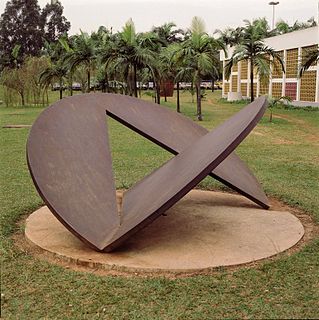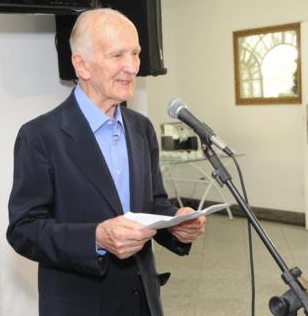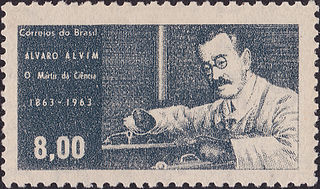Santiago Americano Freire (born 1908, Nova Friburgo, State of Rio de Janeiro; deceased, May 24, 1997, Belo Horizonte, State of Minas Gerais, Brazil) was a scientist of many interests and fields of works in science and culture.
Santiago Americano Freire (born 1908, Nova Friburgo, State of Rio de Janeiro; deceased, May 24, 1997, Belo Horizonte, State of Minas Gerais, Brazil) was a scientist of many interests and fields of works in science and culture.
He attended high school at the Colegio Militar de Realengo, Rio de Janeiro (Military College) and got his medical degree in 1932, at the Faculdade Nacional de Medicina, (National Faculty of Medicine), in the city of Rio de Janeiro. After graduation he established his medicine practice in Guarapuava, state of Paraná.
He got his interest for the study of the human mind and psychiatry when he was a resident student in the Hospício Nacional da Praia Vermelha in the city of Rio de Janeiro (National Hospice of Praia Vermelha). He was discontented with the scientific and financial resources for the treatment of mental patients and not attracted to psychiatry at that time. He had been even psychoanalyzed and was initiated in the psychoanalytic activities, but he could not "see the possibility of being of help to his heart content". [1]
From 1942 onwards, he conquered a chair of Pharmacology and Experimental Therapeutics in the Medicine Faculty of the Universidade Federal de Minas Gerais(UFMG) where he worked for 30 years. Besides a M.D., he became an expert on pharmacology and acquired a conspicuous exactness on the methodology of experimental science and developed with many of his students, a series of drugs and obtained many active extracts of Brazilian tropical plants.
Freire was able to reconcile his duties of his chair of Pharmacology with his clinical practice as a M.D. and did research and developed concepts on the development of psychoses and neuroses. He supported the theory of “imprinting”, of “reconditioned reflex” one of the conditioner of neurosis syndromes and created a theory of four new neuroses: the Rejection Syndrome, the Neurosis of Hate, the Neuroses of Insecurity- Anxiety and the Neurosis of the Incestuous Links.
All his research results, with documented case histories of his clinic and also those described by Freud, were object of his book Neurosanálise,( Neurosisanalysis) published in 1977, by the Printing House of the UFMG. This book is well known by the psychoanalytic circles of Rio de Janeiro and Minas Gerais states.
Because he brings new ideas contrary to the concepts of the psychoanalytic establishment he has been much criticized, causing controversy. Particularly, because his book provided methodology to make a brief analysis of neurotic patients in about 20 to 30 minutes. In many cases, he achieved the cure of his patients in weeks or a couple of years; he also succeeded to improve the behavior of autistic children, in the Instituto Pestalozzi in collaboration with Helena Antipoff. Besides the development of his theoretical concepts his book contains sections on the "techniques for the precocious diagnosis and brief therapy of neuroses" and about 132 references on which he based his ideas. He applied this techniques till the very day of his sudden death in 1997, when he had an alleged heart failure while he was closing manually the iron-gate of his house garage.
After publishing of his neuroanalysis, Santiago started writing a new book on Psichosisanalysis: dealing with the psychodynamic, genetics and neurochemistry of the pathogenesis of schizophrenics. He introduced part of his book in lectures in the Associação Médica de Minas Gerais (“Medical Association of Minas Gerais”) and the Academia Mineira de Medicina(“ Medicine Academy of Minas Gerais”,. [2] In both these institutions he also gave lectures on the Cosmic Origin of the Biological Rhythms and Creativity and Unconscious of Carl Gustav Young.
In the 15 years prior to his death he work and wrote hard and extensively, and left both in Portuguese and English final digitized manuscripts which unfortunately he was unable to see published. In one of them, Violence Origin(1993) he proposed new approach and discussed many issues particularly those of Fromm, Toynbee, and Young related to the matter. Violence Origin was sent to several institutions including to the United Nations Organization in New York but he never got any answer from UNO.
Another tract of Santiago personality was that by influence of his wife Ariadne, who was an artist painter, he acquired a deep interest in the arts. This was also enhanced, because he for a time hosted in his home the famous painter Alberto da Veiga Guignard, who had a feeble healthy condition. Santiago became his voluntary private doctor. Guignard owes his life—and much of his present success to the dedicated Santiago Americano Freire, who nursed him back to health from a nearly fatal case of the diabetes failure. He also arranged that Guinard got a state pension of $100 a month; further Santiago provided most of his exhibitions. In one year alone Guignard sold more than 100 of his paintings.
As a result, Santiago became a painter himself. He was also a close friends of Brazilian artists such as Inimá de Paula. Thus Santiago left many pictures of his authorship some of which after his death went into auction. [3]
In addition, he wrote a master piece “Harmonia cósmica na pintura de Leonardo (da Vinci), (Cosmic Harmony in the paintings of Leonardo), a well illustrated book also published, in 1965, by UFGM Printing House. This work was sent to most relevant libraries in Brazil and abroad. In this work, he maintains that Leonardo, before painting his pictures, used to draw a series of geometrical figures in order to get a harmonic balance between his work and the numbers that can be found in the geometry of the known universe of his epoch, that is the solar system.
Santiago found Leonardo’s pentagon structure whose circles on which the pentagon is supported obey a geometric progression which correspond to the orbits of planets of the solar system. Santiago deduced the mathematical expression of that and the stereo perspective which he called the “Mathematics Philosophy in Leonardo’s work”. Thus “Santiago’s Leonardo” contributed with many other published works by many authors of different countries, to unveil the mysteries which involve the life of this great genius of the Renaissance period. Besides Santiago’s discoveries allowed him to transfer to his own canvas this cosmic harmony.
Santiago also had a profound interest in Physics and Cosmology. He wrote in 1970 The quantic field structure theory, published, in 1970 by UFGM Printing House, where he deals with these complex matters.

Minas Gerais is a state in Southeastern Brazil. It ranks as the second most populous, the third by gross domestic product (GDP), and the fourth largest by area in the country. The state's capital and largest city, Belo Horizonte, is a major urban and finance center in Latin America, and the sixth largest municipality in Brazil, after the cities of São Paulo, Rio de Janeiro, Salvador, Brasília and Fortaleza, but its metropolitan area is the third largest in Brazil with just over 5.8 million inhabitants, after those of São Paulo and Rio de Janeiro. Nine Brazilian presidents were born in Minas Gerais, the most of any state. The state has 10.1% of the Brazilian population and is responsible for 8.7% of the Brazilian GDP.

Luz is a Brazilian municipality located in the West part of the state of Minas Gerais. Luz is located between the city of Araxá and the capital city of the state of Minas Gerais, Belo Horizonte. The population is 18,257 in an area of 1172 km². The city belongs to the Central Mineira region and to the micro-region of Bom Despacho. It became a municipality in 1923.

Mineiro, Mineirês, or the Brazilian mountain dialect, is the Brazilian Portuguese term for the characteristic accent spoken in the heart of the Brazilian state of Minas Gerais, and also in its capital, Belo Horizonte, and its historical cities. Ten million people, about half of the state's population, speak it.

Inconfidência Mineira was an unsuccessful separatist movement in Brazil in 1789. It was the result of a confluence of external and internal causes in what was then colonial Brazil. The external inspiration was the independence of thirteen British colonies in North America following the American Revolutionary War, a development that impressed the intellectual elite of particularly the captaincy of Minas Gerais. The main internal cause of the conspiracy was the decline of gold mining in that captaincy. As gold became less plentiful, the region's gold miners faced increasing difficulties in fulfilling tax obligations to the crown. When the captaincy could not satisfy the royal demand for gold, it was burdened with an additional tax on gold, called derrama.

Ponte Nova is a municipality in central-eastern Minas Gerais state, Brazil.

The Guignard University of Art of Minas Gerais is a university of fine arts in Belo Horizonte, Minas Gerais, Brasil. It was founded on 28 February 1944 by the Brazilian painter Alberto da Veiga Guignard (1896-1962) on request of Juscelino Kubitschek, mayor of Belo Horizonte and later President of Brazil. Guignard became a noted arts educator in Brazil and remained a professor at Guignard for the remainder of his life.
Simon Schwartzman is a Brazilian social scientist. He has published extensively, with many books, book chapters and academic articles in the areas of comparative politics, sociology of science, social policy, and education. In 1996, Schwartzman was awarded the Grand Cross of the Brazilian Order of Scientific Merit for his contributions to the cause and development of science in Brazil. In recent years, Schwartzman has written extensively on issues related to brain drain and brain circulation in the academic world, the Affirmative Action program in Brazilian higher education, and equity in education. He has been part of international teams of experts convened by OECD and The World Bank to advise governments on higher education, science and technology policies.

Purian is a pair of extinct languages of eastern Brazil:
Djalma Guimarães, was a pioneer Brazilian geochemist. He was Professor Emeritus at the Ouro Preto Mining School and at the Federal University of Minas Gerais, in Belo Horizonte. At both institutions, he taught geological sciences for over 35 years.

Felixlândia is a Brazilian municipality located in the northeast of the state of Minas Gerais. Its population as of 2020 was 15,433 living in a total area of 1,553 square kilometres (600 sq mi). The city belongs to the statistical mesoregion of Central Mineira and to the statistical microregion of Curvelo. It became a municipality in 1948.

The State University of Minas Gerais. is a Brazilian public university. It is the third largest university in the state of Minas Gerais, second only to the Federal University of Minas Gerais and the Federal University of Uberlândia. It was founded in 1989 in Belo Horizonte, Minas Gerais, Brazil. Besides Belo Horizonte, its campuses are distributed across several cities in the Minas Gerais states.
Saul Alves Martins was a Brazilian anthropologist and folklorist, professor of Federal University of Minas Gerais (UFMG). Formed in Social Sciences, master and doctor in the area and for years devoted himself to the study and teaching of anthropology, with an emphasis on folklore and the tradition of Minas Gerais.

Amílcar Augusto Pereira de Castro was a Brazilian artist, sculptor and graphic designer.

Martim Francisco Ribeiro de Andrada was a Brazilian association football coach. He is widely credited with the invention of the 4–2–4 formation when guiding his first club, the Villa Nova AC of Nova Lima, to the State Championship of Minas Gerais in 1951. He won further state championships with Atlético Mineiro of Belo Horizonte in 1953, CR Vasco da Gama of Rio de Janeiro in 1956 and SE Gama of Brasília in 1979. Other clubs he coached include Corinthians, Cruzeiro, America FC of Rio de Janeiro and Athletic Bilbao in Spain. With Bangu AC he won the State Champions' Cup of 1967.
The Torneio dos Campeões - the "Tournament of Champions" - was an interclub tournament for association football clubs from Brazil, organised in 1967 by the football association of the state of Minas Gerais, the Federação Mineira de Futebol. Participants were the 1966 state champions of

Messias Pereira Donato was a Brazilian lawyer, teacher, writer, philosopher, magistrate and jurist. Born in Bahia, graduated in law at the Federal University of Minas Gerais (UFMG), having held the judiciary work in Minas Gerais (MG) over 20 years, teaching for 22 years, as Professor of Labour Law Holder UFMG, having been Director of the Law School. In 1934, at age 13, was taken by his father, the farmer Henrique Pereira Donato, of Guanambi until Malhada- BA on the banks of the São Francisco River. Covered about 110 km mounted "by mule" a journey that took three days. From Malhada followed alone steam to Pirapora - MG and this came from railroad train to the end of twelve days of travel to get to Belo Horizonte, where he continued his studies.

Álvaro Freire de Villalba Alvim was a Brazilian physician, pioneer in radiology and radiotherapy. He studied in France with Pierre and Marie Curie and performed the first radiograph in Brazil, which was on the xiphopagus case for Brazilian surgeon Eduardo Chapot Prévost.

Alberto da Veiga Guignard also known as Alberto Guignard or Guignard was a Brazilian painter who became renowned for his depictions of the landscapes of Minas Gerais.
Djalma Bastos de Morais was a Brazilian engineer and politician who served as Federal Minister of Communications.
João Camilo de Oliveira Torres was a Brazilian writer, professor, historian and journalist.
This article includes a list of general references, but it lacks sufficient corresponding inline citations .(June 2009) |
This section needs additional citations for verification .(January 2009) |